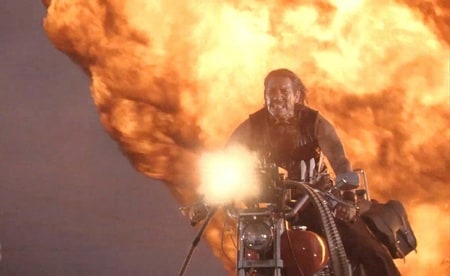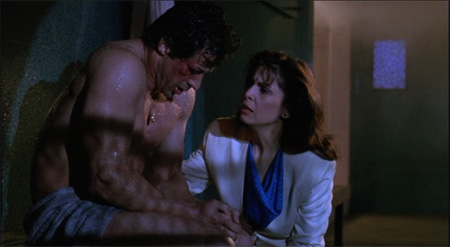For those who witnessed the faux Machete trailer at the beginning of the Quentin Tarantino/Robert Rodriguez double bill Grindhouse and wished it were a real movie, your prayers have at long last been answered. And, happily, Machete is actually good; a delirious, irresistible blast of R-rated mayhem benefitting from top-notch filmmaking techniques, a tongue-in-cheek social commentary, and an obvious affection for schlocky movies of the '70s and '80s. Directors Rodriguez and Ethan Maniquis knew exactly what the fans wanted with this feature-length expansion, and went wild to deliver everything one craves from an exploitative B-movie: over-the-top, graphic violence, scenery-chewing villains, plenty of cheese, a plethora of one-liners, and some female nudity. It's destined to leave you with a big dumb grin on your face.

The titular Machete (Trejo) is a former Federale whose life and career comes crashing down when his family is killed by ruthless drug kingpin Torrez (Seagal). Three years later, Machete has taken to the life of a day labourer who becomes lost amidst the millions of Mexican faces in south Texas. Much like the events seen in the original faux trailer, Machete is offered $150,000 by a shady businessman (Fahey) to assassinate United States senator John McLaughlin (De Niro), but finds himself to be a patsy in a setup designed to make the senator a more sympathetic figure. As it turns out, Torrez is also involved with the senator scheme. When Machete learns of Torrez's involvement, he and his compatriots declare war on McLaughlin's new world order, and begin arming themselves with an array of deadly weaponry.
Like Rodriguez's Planet Terror, Machete is a campy contemporary take on the excesses of classic schlock cinema. Rodriguez and his crew have crafted a tongue-in-cheek, amusing blood-soaked tale of vengeance and conspiracy which tracks Machete as he encounters all types of corruption and idealism. The only questionable aspect of Machete is that Rodriguez chose to use this sleazy exploitation epic as a platform for political grandstanding - the film denigrates U.S. immigration policy, and addresses it in an anything-but-subtle way. All of the speechifying slows down the frenetic pace from time to time. I'd rather sit back and enjoy the silly R-rated carnage, not be challenged by any profound underlying themes. Granted, it's easy to overlook these shortcomings and enjoy the movie, but it could've been tighter and more enjoyable had this political content been excised or cut down.

Thus, while Machete is slightly overstuffed and overlong, the film really works when it buckles into its groove, goes for the jugular and embraces its pedigree. This is a motion picture specialising in the ridiculous and the insane, and the more insane it gets, the more fun it is. Happily, the action is coherent, devilishly enjoyable and constantly exhilarating. This is thanks in large part to Robert Rodriguez, who's so good at handling these types of movies that he should stop making god-awful kiddie flicks (like Shorts) and focus on giving the world more awesome films like Machete. Naturally, it's impossible to take anything seriously here (not even the death of Machete's family) but this is to be expected. The tone is spot-on, with the film asking us to take all of the absurdly over-the-top proceedings with a grain of salt.
It's interesting to note that significant chunks of the Machete were reportedly filmed in 2007 for the faux trailer, while the "fill in" segments were filmed more recently for this feature-length expansion (certainly, most of the stuff from the trailer seems to be here). If this is the case, the seams are not visible. Also note-worthy is the fact that Rodriguez chose not to give the movie a lot of scratch damage (like in Grindhouse) to give the impression that it has been locked in somebody's basement for decades. The movie's opening sequence has scratch damage, but the technique was subsequent abandoned for the remainder of the flick. The scratch damage technique would've made the film more enjoyable, for sure, but its absence remains a relatively minor flaw. However, the colour scheme throughout the film seems to resemble schlocky cinema from the '70s and '80s, which is a welcome aesthetic decision.

Danny Trejo has long been one of Rodriguez's go-to actors, and he's absolutely perfect for the role of Machete. Trejo played the material straight despite its ludicrously over-the-top nature, and his delivery of one-liners such as "Machete don't text" are priceless. He was born to play Machete, with his craggily face and badass presence evoking memories of Charles Bronson and Lee Marvin. The star has played supporting characters for many years now (and has nearly two hundred credits on his acting résumé), but this is the iconic role he will likely be best remembered for. Meanwhile, the supporting cast is comprised of the most random selection of famous actors in recent memory, but everyone nonetheless hit their mark. Robert De Niro was game for the tone that Rodriguez and Maniquis were aiming for, and he's frequently amusing. Similarly, Cheech Marin was a terrific choice for the gun-toting priest, and his scene to shine is awesome. Michelle Rodriguez and Jessica Alba are also convincing in their respective roles, while Jeff Fahey and Don Johnson chewed the scenery as memorable villains. Steven Seagal's performance is notably terrible (is he meant to be Mexican?), but he's at least well-suited to the nature of the role. Rounding out the cast is Lindsay Lohan, who features here as a drugged up slut. It's doubtful Lohan was even acting...
In its own way, Machete definitely works. For my money, this is some of the purest fun to be released during 2010, along with The Expendables, Kick-Ass and Scott Pilgrim vs. the World. It pretty much delivers both what it promised and what fans of the faux trailer yearned for. Granted, if you're not an action fan and if you found the faux trailer to be repugnant, there's nothing you'll enjoy here. But if you loved the faux trailer, there's a good chance you'll love the whole thing. When the film's end credits tout the possibility of two sequels - Machete Kills and Machete Kills Again - it's virtually impossible not to feel a tinge of giddiness at the prospect.
8.2/10
 Login
Login
 Home
Home 183 Lists
183 Lists 1674 Reviews
1674 Reviews Collections
Collections
 0 comments,
0 comments, 
































